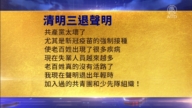【新唐人2013年07月30日訊】7月28號,中共審計署在官網發佈消息聲稱,「近日,根據國務院要求,審計署將組織全國審計機關對政府性債務進行審計。」主持起草中共第一部企業破產法的曹思源對本臺記者表示,當局近期這項對地方債務的審計,可能是對中國各地負債累累的地方政府來一個摸底。不過,專家分析,地方債務大多涉及官員貪腐,真實的曝光地方政府的負債情況會遇到重重阻力。
據官方媒體報導,7月26號國務院發出「特急明電」,要對全國政府性債務進行審計。全國性審計工作將於8月1號起全面展開。這次審計署將對中央、省、市、縣、鄉五級政府性債務進行徹底摸底和測評。
作為美國第四大城市的底特律最近申請破產。曾經在中共國務院辦公廳和國家體改委工作,現任「思源兼併與破產諮詢事務所」所長的曹思源對《新唐人》表示,中共過去認為社會主義國家不存在破產問題,因此廢除了民國時期的《六法全書》包括破產法。
中國思源兼併與破產諮詢事務所所長曹思源:「大陸的破產法重新制定是1980年我發表文章首先提出來,然後我到國務院工作的時候繼續努力,最後進行起草工作。企業破產法在88年11月1日開始生效。」
但是到目前為止,破產的觀念僅限於企業,政府長期以來被認為不可能破產。曹思源表示,這一次底特律的申請破產,使人們猛醒,只要是債務人不能夠清償到期債務,還不起債,就有可能陷於破產。因此人們重新注意地方政府破產問題。為了防止這種情況突然發生,審計部門決定對全國地方政府開展債務審計。
曹思源:「地方政府因為長期以來沒有破產的觀念,舉債沒有任何的嚴密思維。我舉債能不能還啊?還得起、還不起啊?我拿甚麼去還啊?這些問題都不考慮。我只要想借債就借債,想擔保就擔保,所以地方債臺高築。」
中國有12座所謂的鬼城,就是大面積開發但是無人居住的房地產。它們包括內蒙古鄂爾多斯康巴甚、河南鄭州鄭東新區、河南鶴壁、遼寧營口、江蘇常州等地。曹思源認為,如果房地產開發有投入、無產出,這12個城市將面臨破產還債的問題。
審計地方政府的債務,很可能牽出背後的官員貪腐黑幕,宣佈地方政府破產可能將令地方領導人烏紗帽不保。這使得從地方到中央,曝光真實債務狀況和承認地方政府破產,都存在重重阻力。
曹思源:「越是掩蓋債務問題越加混亂。就好像是地上有人埋了地雷,好的辦法是通過排雷裝置,把這個地雷排除避免踩上地雷、避免損失巨大。相反,如果掩蓋這個地雷就是鋪上稻草和鮮花,一片鶯歌燕舞、最後踩上去就爆炸了,人仰馬翻,損失更大。」
現在中國很多地方政府的財政開支遠遠超過預算。
北京天則經濟研究所所長助理段紹譯表示,地方政府修建豪華政府大樓,樹立形象工程,導致很多地方政府負債纍纍。而中共的制度缺陷也是債務飆升的一個原因。段紹譯說,中共官員的政績評估體系當中,只看GDP和形象工程,卻不看負債多少。
段紹譯:「薄熙來在重慶的時候,他建了很多形象工程,比如唱紅歌搞十萬人比賽,政府沒有去考核他花了多少時間、浪費了多少精力。還有重慶街上銀杏樹多了。市民感覺很好。但是薄熙來欠了幾千億的財政欠款,很多人根本就不知道。 」
今年中共兩會期間,審計署副審計長董大勝表示,截至2010年底,中共中央債務規模在7.7萬億元人民幣左右,地方債10.71萬億。國際貨幣基金組織本月早先時候估算,中央政府和地方政府的債務佔到國民生產總值的45%。
採訪編輯/秦雪 後製/李月
Local Debt Audit Reveals Bankruptcy of China’s Many Cities
On July 28, the Chinese Communist Party (CCP)’s
National Auditing Office (NAO) announced that:
“Recently, following the State Council’s requirements,
NAO will organize national audit institutions to
audit government debts."
Cao Siyuan, who presided over drafting the CCP’s first
Enterprise Bankruptcy Law, told our reporters that
this audit on local debts could be an assessment of
local governments who are in a serious debt situation.
However, experts say that since most local officials are
involved in corruption, real exposure of local government debt
will encounter a lot of resistance.
According to China’s official media reports,
on July 26, the State Council issued an urgent message
requesting an audit of government debts across the country.
The national audit work will start full-scale on August 1.
This audit will hold a thorough diagnostic evaluation over
the debts of the five levels of government:
central, provincial, city, county and township.
Detroit, the fourth biggest city in the U.S.,
has recently filed for bankruptcy.
Cao Siyuan, president of the Siyuan Merger and Bankruptcy
Consulting Firm, once worked in the General Office
of the State Council and the CCP’s State Council General.
Cao told NTD that, the communist regime thinks as a
socialism country, it wouldn’t have bankruptcy issue,
thus the bankruptcy law in China was abolished previously.
Cao Siyuan: “In 1980, I was the first one who published
an article raising the need to re-enact China’s bankruptcy law.
I continued this effort while I worked at the State Council.
Eventually I worked on drafting it.
The Enterprise Bankruptcy Law came into effect on
November 1, 1988."
So far, the concept of bankruptcy is limited to business.
Government has long been considered impossible go to bankrupt.
Cao Siyuan said the bankruptcy of Detroit woke people up.
As long as a debtor can’t pay off maturing debt,
they may fall into bankruptcy.
So people are paying attention to local government bankruptcy.
To prevent this from happening suddenly, the audit department
decided to carry out government debt audits across the nation.
Cao Siyuan: “For a long time, local governments
haven’t had the concept of bankruptcy.
When incurring debts, there was no thinking over thoroughly
questions such as whether and how to pay it back.
They didn’t think about such issues.
They just borrow and get insurance as they wish.
Thus the debt level of local governments is very high."
China has 12 so-called ‘ghost cities,’
large areas of uninhabited real estate development,
including Erdos Kamba of Inner Mongolia,
Zhengdong New District of Zhengzhou and
Hebi city of Henan Province,
Yingkou city of Liaoning Province and
Changzhou City of Jiangsu Province.
Cao Siyuan says without income from the real estate investments,
these 12 cities will face bankruptcy and debt repayment problems.
Auditing local government debt will likely expose corruption,
and declaring bankruptcy will cause local officials
to lose their positions.
There are layers of obstacles,
from central to local governments,
blocking exposure of the true debt situation
and recognition of local government bankruptcy.
Cao Siyuan: “Cover-up debt makes it increasingly confusing.
It’s like if someone planted a landmine: a good way
to deal with it is to remove it or avoid stepping it.
But if it’s just covered up with lawns and flowers,
whoever steps on it will cause an explosion."
China’s many local governments’ fiscal expenditures
far exceeds their budgets.
Duan Shaoyi, assistant director at Beijing
Tianze Institute of Economics, says
local governments build luxury government buildings
to brush up their image,
resulting in the huge debts of many local governments.
Deficiency of the CCP system is also a reason for soaring debt.
Duan Shaoyi says the performance index for CCP officials
only looks at GDP and image projects, not the debt level.
Duan Shaoyi: “Bo Xilai launched many image projects
when he was in Chongqing,
such as holding the competition involving 10 thousand
people singing CCP songs, for example.
The government didn’t consider
how much time and money he spent.
There are also more trees on Chongqing streets.
But Bo Xilai incurred several billion dollars in debt.
Many people knew nothing of it."
During the CCP’s Two Sessions this year, Dong Dasheng,
Deputy Auditor General of the CCP Audit Commission said that
as of the end of 2010, CCP Central debt is over 7.7 trillion yuan
($1.3 trillion), and local debt is 10.7 trillion yuan ($1.7 trillion).
The International Monetary Fund said earlier this month,
that China’s central and local government debts are estimated
to account for 45% of China’s GDP.


























